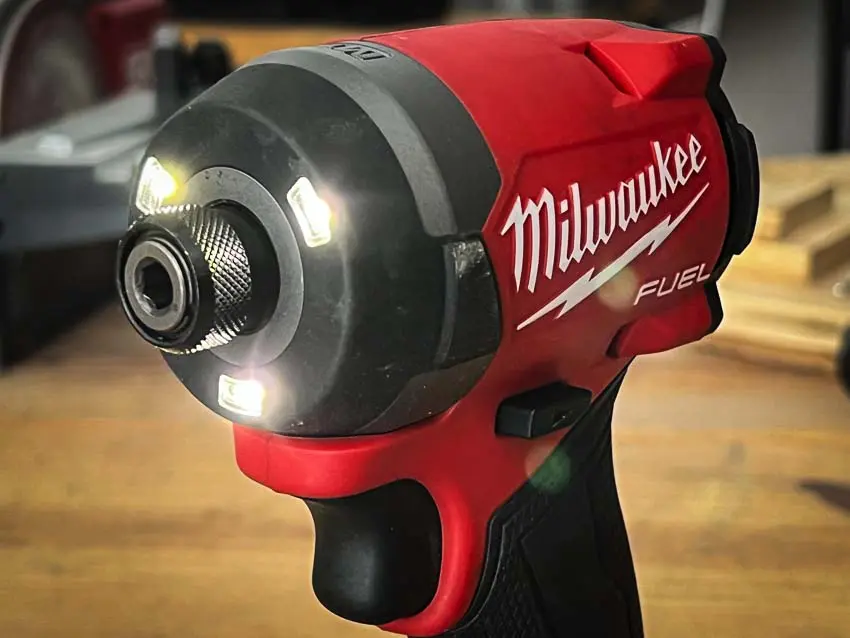From time to time we still run across folks who don’t quite understand how an impact driver works. Impact drivers are an essential tool for any Pro. They let you apply more force (or torque) than a drill. Used in tandem, a cordless drill handles hole-making while an impact driver sets or sinks the fasteners. For basic screwdriving, an impact driver might be the only tool you need. If you have ever wondered how an impact driver works, this article should help answer your questions.
Table of Contents
How an Impact Driver Works Internally
First of all, check out our impact driver vs drill article if you want an overview of the difference between these two tools. We don’t want to rehash that here. Instead, we want to go over how exactly an impact driver works internally to generate its impressive torque.
Constant Pressure vs Impacts
A regular drill applies static rotational force to the shaft and, consequently, the bit. In other words, it exerts a constant pressure to rotate the chuck. As the job gets more difficult, inertia kicks in. That drill fights the user and wants to exert just as much force on your hand and arm as you are exerting on the bit. If the bot binds, but the tool continues delivering all of its power, you can encounter some serious issues!
An impact driver works by relying on something else entirely. This makes it a truly unique tool. An impact driver creates rotational impact force when you need additional torque. It uses a spring, hammer, and anvil to accomplish this.
As the motor turns the shaft, the spring compresses and then releases. This forcefully drives the hammer down until it drops into place where it can strike rotationally against the anvil. This action happens very rapidly. In fact, most impact drivers hit more than 50 times every second. This creates much more force than a drill can typically muster in a similarly sized tool.
It’s also very loud, so wear ear protection when using an impact driver for extended periods of time.

Pushing vs Rapid Punching
Here’s another way to think about it: Using a drill is like setting your hands against an object and pushing. Using an impact driver is like punching it rapidly. Think of it like the rapid punching of legendary king fu master IP Man… except less messy. You use the same muscles to create both forces, but the rapid punches deliver much greater force overall. A punch also only impacts the surface for a brief moment while you can engage a push much longer.

One caveat is that an impact driver works by punching rotationally. So the work they do helps the twisting motion of a bit as it works. This also has the added effect of keeping the bit engaged with the fastener—causing less camout.

Where and When an Impact Driver Really Works Well
Just like a punch, the impact mechanism creates a more violent action. That’s why you see many Pros shy away from using impact drivers with twist drill bits and spade bits. While it gets the job done, it’s not nearly as smooth of an experience. An impact driver can also “bind up” as the mechanism is designed not to cause reactive force on the user. The net result is that a spade bit can more easily bind up in the hole and stop drilling.
On the other hand, that violence works perfectly for driving screws. An impact driver also tends to drive higher torque fasteners much more quickly than a drill. The speed of the hammer/anvil impact combined with the additional force gives you the ability to drive longer and larger diameter screws or fasteners than you can expect a drill to handle.
Impact Drivers Provide Lots of Torque
The practical implication of the impact driver mechanism comes down to how it provides torque. Got a long or larger ledger screw or lag bolt? The impact driver is the best tool for this type of work.
You can certainly drive long ledger screws or lag bolts using a standard drill. However, as you drill further and further, the torque requirement increases. This makes you have to fight the tool for control.
Compare that to using an impact driver to drive ledger or lag screws. You can drive them all the way to the bottom using just one hand!

Typically, Impact Drivers are Smaller in Size
The icing on the cake is that impact drivers are typically smaller, lighter, and able to get into tighter spaces. Much of this is due to the compact hex chuck and lack of a mechanical clutch.
The best impact drivers measure less than 5 inches in length! As they also won’t wrench violently in a bind-up like a high-torque drill, that gives you more confidence in awkward angles and cramped spaces.
If that all sounds, well, impactful, you’re not alone. Impact drivers are among the most popular cordless tools on the jobsite.

My Recommendation — Get an Impact Driver and Try It!
I for one can say that an impact driver has saved my arm on many tasks. While loud, it offers lots of torque without forcing that torque back on your wrist and hand. This makes it incredibly useful for ledger screws, lag bolts, and sequential screwing on decks.
Hopefully, knowing how an impact driver works will also help you understand when and where to choose it over a drill. Those are the little tidbits of knowledge that will help as you make the transition from apprentice to seasoned Pro. Most of us carry both tools and use them specifically on the tasks for which each is optimized. Considering most manufacturers sell them in a combo kit, you can almost always start your tool journey with both in your tool bag.



